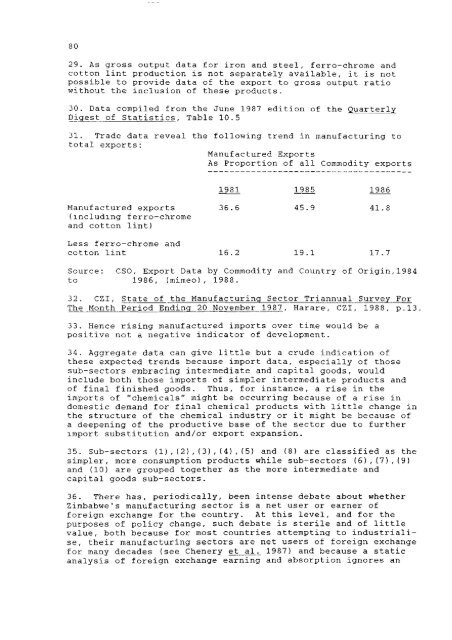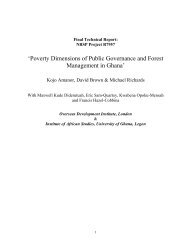Zimbabwe - Overseas Development Institute
Zimbabwe - Overseas Development Institute
Zimbabwe - Overseas Development Institute
Create successful ePaper yourself
Turn your PDF publications into a flip-book with our unique Google optimized e-Paper software.
29. As gross output data f o r i r o n and s t e e l , ferro-chrome and<br />
cotton l i n t production i s not separately a v a i l a b l e , i t i s not<br />
possible to provide data of the export to gross output r a t i o<br />
without the i n c l u s i o n of these products.<br />
30. Data compiled from the June 1987 e d i t i o n of the Quarterly<br />
Digest of S t a t i s t i c s , Table 10.5<br />
31. Trade data r e v e a l the f o l l o w i n g trend i n manufacturing to<br />
t o t a l exports;<br />
Manufactured Exports<br />
As Proportion of a l l Commodity exports<br />
1981 1985 1986<br />
Manufactured exports 36.6 45.9 41.8<br />
( i n c l u d i n g ferro-chrome<br />
and cotton l i n t )<br />
Less ferro-chrome and<br />
cotton l i n t 16.2 19.1 17.7<br />
Source: CSO, Export Data by Commodity and Country of Origin,1984<br />
to 1986, (mimeo), 1988.<br />
32. CZI, State of the Manufacturing Sector Triannual Survey For<br />
The Month Period Ending 20 November 1987, Harare, CZI, 1988, p.13.<br />
33. Hence r i s i n g manufactured imports over time would be a<br />
p o s i t i v e not a negative i n d i c a t o r of development.<br />
34. Aggregate data can give l i t t l e but a crude i n d i c a t i o n of<br />
these expected trends because import data, e s p e c i a l l y of those<br />
sub-sectors embracing intermediate and c a p i t a l goods, would<br />
include both those imports of simpler intermediate products and<br />
of f i n a l f i n i s h e d goods. Thus, f o r instance, a r i s e i n the<br />
imports of "chemicals" might be occurring because of a r i s e i n<br />
domestic demand f o r f i n a l chemical products with l i t t l e change i n<br />
the s t r u c t u r e of the chemical i n d u s t r y or i t might be because of<br />
a deepening of the productive base of the sector due to f u r t h e r<br />
import s u b s t i t u t i o n and/or export expansion.<br />
35. Sub-sectors (1),(2),(3),(4),(5) and (8) are c l a s s i f i e d as the<br />
simpler, more consumption products while sub-sectors (6),(7),(9)<br />
and (10) are grouped together as the more intermediate and<br />
c a p i t a l goods sub-sectors.<br />
36. There has, p e r i o d i c a l l y , been intense debate about whether<br />
<strong>Zimbabwe</strong>'s manufacturing sector i s a net user or earner of<br />
f o r e i g n exchange f o r the country. At t h i s l e v e l , and f o r the<br />
purposes of p o l i c y change, such debate i s s t e r i l e and of l i t t l e<br />
value, both because f o r most countries attempting to i n d u s t r i a l i <br />
se, t h e i r manufacturing sectors are net users of f o r e i g n exchange<br />
f o r many decades (see Chenery et a l . 1987) and because a s t a t i c<br />
a n a l y s i s of f o r e i g n exchange earning and absorption ignores an
















